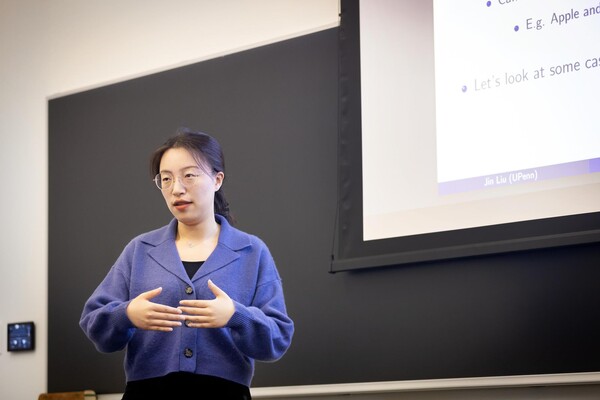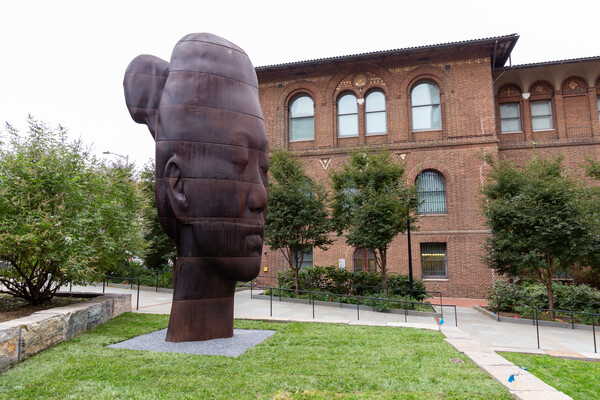
(From left) Doctoral student Hannah Yamagata, research assistant professor Kushol Gupta, and postdoctoral fellow Marshall Padilla holding 3D-printed models of nanoparticles.
(Image: Bella Ciervo)

Organizer Bayard Rustin had enormous influence on a host of social movements in the 20th century, including pacifism, socialism, workers’ rights, and gay rights.
One of the chief areas on which Rustin had an effect was the Civil Rights Movement. He led the 1963 March on Washington for Jobs and Freedom and conceived a wide-ranging crusade blending diverse factions and campaigns for justice.
“He envisions the Civil Rights Movement, starting with the Montgomery bus boycotts, as catalyzing a broader social movement,” says Connor Nakamura, a fourth-year from San Francisco majoring in history and minoring in urban studies and creative writing. “He was able to think creatively about the possibilities for social change.”
Nakamura’s senior thesis, “Cloaked Radicalism: Bayard Rustin and the Socialist Civil Rights Strategy,” documents Rustin’s life from 1955 to 1965, when he was thinking, theorizing, and grappling on a practical level with how a movement based around nonviolence in the American South could solve other issues around the country.
Nakamura’s research draws on archives that include the Swarthmore College Peace Collection and the New York Public Library’s Schomberg Center for Research in Black Culture in Harlem. At the Schomberg Center, he tapped into oral-history interviews with Rustin and others conducted by historian August Meier, who recognized the importance of their real-time reactions to events. Nakamura also used Rustin’s writings, newspaper archives, and magazines including Liberation, co-founded by Rustin’s mentor A.J. Muste, and Dissent.
Though Rustin died in 1987 at age 75, his ideas remain highly relevant today, with a focus on creating economic opportunity, Nakamura says.
“A center of his political strategy was the question of full employment, and organized labor was very key in his formulations,” Nakamura says. “Even early on, in the mid-to-late 1950s, he was thinking about automation and deindustrialization in the South and how these forces would affect workers at the margins of society, which, of course, in the South were Black workers.”
Rustin was primarily a behind-the-scenes organizer for much of the decade, which was both a limitation and an asset, Nakamura says. Other limitations on his leadership and career were Rustin’s sexuality, as a gay man, and previous membership in the Communist Party.
Along with Martin Luther King Jr., he organized the Southern Christian Leadership Conference but was fired by King in 1960 after a New York congressman threatened to falsely accuse Rustin and King of having an affair. In 1963, he was brought back into the movement to organize the March on Washington alongside labor and civil rights leader A. Philip Randolph.
“That remains his biggest accomplishment,” Nakamura says. “After that, he begins to write more publicly in outlets like Dissent.” Rustin’s most famous article, published in Commentary in 1965, was “From Protest to Politics: The Future of the Civil Rights Movement.”
Part of Rustin’s writing and inspiration stems from “how fluid his intellectual circle and life was,” Nakamura says. “He formed a bridge between these left-wing groups and the Civil Rights Movement.” Among his writings were collaborations with other progressive thinkers, and he often ghostwrote for civil rights leaders including King.
More broadly, Rustin represents “a path not taken within the Civil Rights Movement,” says Nakamura. “He was really concerned about bringing more people into the movement and reducing alienation.”
He also introduced the concept of nonviolence to the movement’s leadership, an idea that shaped both the Montgomery boycott and the 1963 March on Washington.
“For Rustin, nonviolence was important because it gave the movement a sense of the moral high ground,” Nakamura says. “He recognized that a nonviolent character was really essential for growing the movement.”

(From left) Doctoral student Hannah Yamagata, research assistant professor Kushol Gupta, and postdoctoral fellow Marshall Padilla holding 3D-printed models of nanoparticles.
(Image: Bella Ciervo)

Jin Liu, Penn’s newest economics faculty member, specializes in international trade.
nocred

nocred

nocred